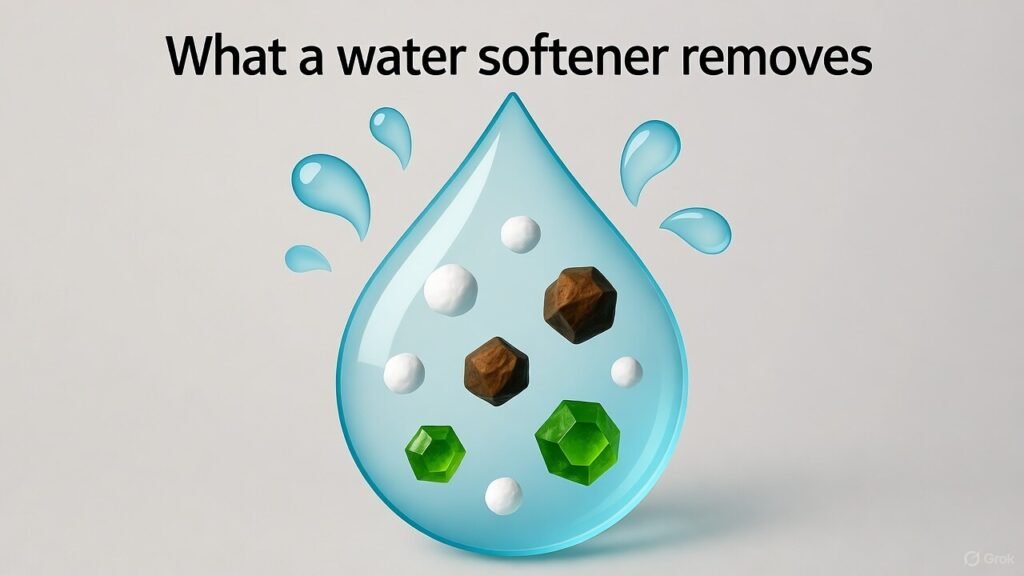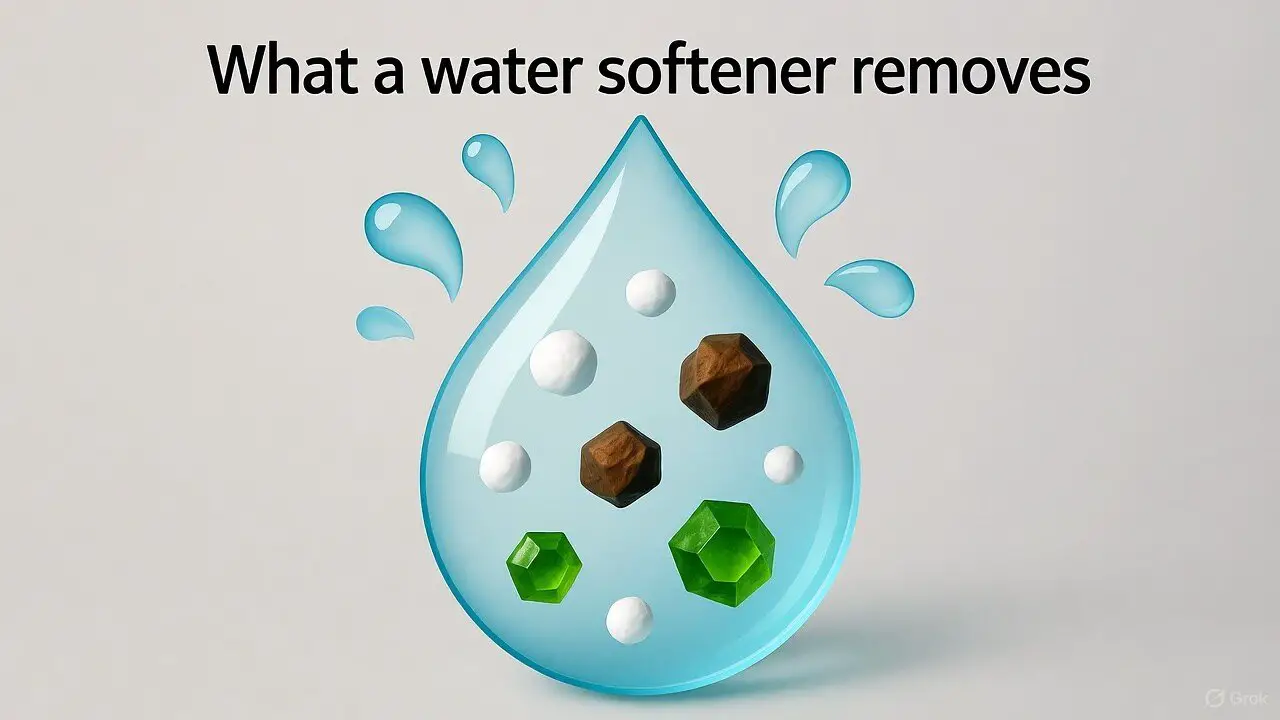If you’re struggling with spotty dishes, stiff laundry, and scale-clogged pipes, you likely have hard water. This common issue affects millions of homes, costing homeowners in damaged appliances, higher energy bills, and endless cleaning frustration. While many people consider installing a water softener, there’s often confusion about what exactly these systems remove from water.
Understanding what a water softener removes—and what it doesn’t—is crucial for setting realistic expectations and creating an effective water treatment strategy for your home. This comprehensive guide will demystify the water softening process, highlight the real water softener benefits, and help you determine if softening is the right solution for your household.
What is Hard Water?
Hard water contains high concentrations of dissolved minerals, primarily calcium and magnesium. These minerals are naturally present as water passes through limestone and chalk deposits in the earth. While not harmful to health, they cause numerous practical problems throughout your home.
Common signs of hard water include:
- White, chalky scale buildup on faucets and showerheads
- Soap scum on shower doors and sinks
- Stiff, rough-feeling laundry after washing
- Dry skin and dull hair after bathing
- Reduced water pressure from scaled-up pipes
- Higher energy bills from inefficient water heaters
- Spotty glassware and dishes from the dishwasher
The degree of hardness is measured in grains per gallon (GPG) or parts per million (PPM), with water above 7 GPG (or 120 PPM) generally considered hard.
How Does a Water Softener Work?
To understand what a water softener removes, you first need to understand the water softener ion exchange process. This is the fundamental mechanism that all traditional salt-based water softeners use to transform hard water into soft water.
Here’s how it works:
- Hard Water Entry: Mineral-rich hard water enters the softener’s mineral tank.
- Resin Bed Contact: The water flows through a bed of tiny polystyrene beads called resin beads. These beads are charged with sodium or potassium ions.
- The Ion Exchange: The resin beads have a stronger negative charge that attracts the positively charged calcium and magnesium ions. As these hardness minerals stick to the beads, the beads release their sodium ions into the water in exchange.
- Soft Water Exit: The water leaving the tank is now “soft”—free of the calcium and magnesium minerals that cause scale and other problems.
When the resin beads become saturated with hardness minerals, the system automatically regenerates by flushing them with a concentrated saltwater (brine) solution, which recharges the beads with sodium ions and washes away the accumulated calcium and magnesium.

What Minerals Do Water Softeners Remove?
Water softeners are specifically designed to target and remove minerals that cause water hardness. The primary minerals removed by water softener systems include:
Calcium (Ca²⁺)
- The most common hardness mineral found in water
- Forms stubborn scale deposits in pipes and appliances
- Reacts with soap to form soap scum
Magnesium (Mg²⁺)
- The other primary hardness mineral
- Contributes to scale formation and soap inefficiency
- Can cause a slightly bitter taste in water
Small Amounts of Iron (Fe²⁺)
- Some water softeners can remove small amounts of ferrous iron (clear-water iron)
- Not effective for ferric iron (red-water iron) that has already oxidized
- Significant iron problems typically require additional filtration
It’s crucial to understand that water softeners specifically target these water softening minerals—they are not designed to remove other contaminants like heavy metals, chemicals, or biological contaminants.
What Water Softeners Do NOT Remove
Just as important as knowing what softeners remove is understanding what they don’t. Many homeowners are surprised to learn that their softened water still contains certain contaminants.
Water softeners typically DO NOT remove:
Chlorine and Chloramines
- Municipal water additives for disinfection
- Can affect water taste and odor
- Chlorine can actually damage softener resin over time, making pre-filtration important
Fluoride
- Added to municipal water for dental health
- Unaffected by the ion exchange process
Bacteria and Viruses
- Biological contaminants require specialized UV treatment or disinfection
Heavy Metals
- Lead, mercury, arsenic, and other toxic metals
- Require specific filtration methods like reverse osmosis or activated carbon
Pesticides, Herbicides, and Pharmaceuticals
- Chemical contaminants that need advanced filtration
Sediment and Particles
- Sand, silt, rust, and other particulates
- Require separate sediment pre-filters
Understanding these limitations is key to creating a comprehensive water treatment approach for your home.
Water Softeners vs Water Filters: Key Differences
The difference between water softener and water purifier systems often causes confusion. While both improve water quality, they serve fundamentally different purposes:
Water Softeners
- Primary function: Remove hardness minerals (calcium, magnesium)
- Method: Ion exchange
- Result: Soft water that prevents scale, improves soap efficiency
Water Filters
- Primary function: Remove contaminants, chemicals, sediment
- Methods: Physical filtration, adsorption, sequestration
- Types: Carbon filters, reverse osmosis, sediment filters, UV systems
- Result: Cleaner, better-tasting, safer water
When to Use Each System:
- Softener only: When hardness is your only concern
- Filter only: When contaminants are the issue but water isn’t hard
- Both systems: The ideal solution for comprehensive water treatment
Many homeowners benefit from installing a whole-house carbon filter before their softener (to remove chlorine and protect the resin) and a reverse osmosis system at the kitchen sink (for premium drinking water).
Benefits of Using a Water Softener
Installing a water softener provides numerous water softener benefits that extend throughout your home:
Prevents Scale Buildup
- Protects pipes, water heaters, and appliances from mineral accumulation
- Maintains water pressure and flow rates
- Extends the lifespan of plumbing systems
Improves Cleaning Efficiency
- Soap and detergent lather better and work more effectively
- Reduces soap scum in bathrooms and kitchens
- Eliminates mineral spots on dishes and glassware
Enhances Personal Care
- Leaves skin feeling softer and less dry after showering
- Makes hair more manageable and shiny
- Requires less soap and shampoo for the same results
Saves Money
- Reduces energy costs by maintaining water heater efficiency
- Extends appliance lifespan (water heaters, dishwashers, washing machines)
- Lowers consumption of soaps, detergents, and cleaning products
Environmental Benefits
- Reduced need for harsh chemical cleaners
- Lower soap and detergent usage
- Longer-lasting appliances mean less waste
Common Problems Water Softeners Solve
Water softeners effectively address several frustrating household issues:
Appliance Protection
- Prevents scale buildup in water heaters (can improve efficiency by 20-30%)
- Protects dishwasher and washing machine components
- Extends the life of coffee makers and other water-using appliances
Plumbing Maintenance
- Prevents mineral accumulation in pipes that reduces water flow
- Eliminates scale on showerheads and faucet aerators
- Reduces the need for pipe descaling or replacement
Laundry Challenges
- Eliminates stiff, rough-feeling clothes and towels
- Prevents mineral-deposited graying of white fabrics
- Allows clothes to last longer and maintain color brightness
Cleaning Frustrations
- Eliminates spotty dishes and glassware
- Reduces soap scum buildup on shower doors and tiles
- Makes cleaning bathrooms and kitchens easier and more effective
While softeners don’t directly improve water taste, many people notice better-tasting water because the softening process removes magnesium, which can impart a bitter taste.
Maintenance Tips for Water Softeners
Proper maintenance ensures your water softener operates efficiently for years:
Salt Management
- Check salt levels monthly and refill as needed
- Use high-purity salt to reduce maintenance issues
- Break up salt bridges (hard crusts) that form in the brine tank
System Settings
- Program regeneration cycles based on your household’s water usage
- Adjust settings seasonally if water usage patterns change
- Ensure the clock is set correctly for time-initiated systems
Protecting Resin Beads
- Install a carbon pre-filter if your water contains chlorine
- Address iron issues with appropriate pre-filtration
- Avoid allowing hard water to bypass the system
Professional Servicing
- Have the system inspected annually by a professional
- Test water hardness periodically to ensure proper operation
- Replace resin beads every 10-20 years as needed
Troubleshooting Common Issues
- If water isn’t soft, check salt levels and regeneration settings
- If you notice salt taste, inspect the injector and control assembly
- If the system runs constantly, check for leaks or incorrect timer settings
Conclusion
Understanding what a water softener removes—primarily calcium and magnesium minerals—helps set realistic expectations for what these systems can and cannot accomplish. While softeners work wonders for eliminating scale, improving cleaning efficiency, and protecting appliances, they’re not designed to remove contaminants like chlorine, fluoride, or bacteria.
The most effective approach to whole-house water treatment often involves pairing water softeners with water filtration systems. A typical comprehensive setup might include a sediment pre-filter, whole-house carbon filter (to remove chlorine and protect the softener resin), the water softener itself, and finally a point-of-use reverse osmosis system at the kitchen sink for premium drinking water.
By understanding the specific minerals removed by water softener systems and their limitations, you can make informed decisions about your home’s water treatment needs and invest in solutions that will deliver the water quality you desire throughout your home.
Ready to transform your hard water problems? Consult with a water treatment professional to test your water and recommend the ideal system configuration for your home’s specific needs.
Can water softeners remove fluoride?
No, water softeners cannot remove fluoride. Fluoride removal requires specific filtration methods like reverse osmosis or activated alumina filters.
Do water softeners remove iron?
Water softeners can remove small amounts of clear-water iron (ferrous iron), but they’re not designed for significant iron problems. For high iron content, dedicated iron filters are more effective.
Are water softeners safe for drinking water?
Yes, softened water is safe for most people to drink. The sodium content increases slightly, but typically remains well below dietary restrictions. Those on strict sodium-restricted diets may want to maintain a hard water line to at least one tap for drinking.
How often should I service my water softener?
Basic maintenance (adding salt, checking settings) should be done monthly. Professional servicing is recommended annually to ensure optimal performance.
Can I install a water softener myself?
While DIY installation is possible for those with plumbing experience, professional installation is recommended to ensure proper sizing, programming, and compliance with local codes.
Do water softeners waste water?
Modern efficient softeners use minimal water during regeneration—typically between 20-50 gallons depending on the model and settings. This is significantly less water than would be wasted dealing with scale-damaged appliances and inefficient water heating.

Anamika is a passionate writer for Eco365Store.com, specializing in topics that inspire a cleaner, greener world. With expertise in home cleaning, recycling, and eco-friendly solutions, she crafts engaging and informative articles that help readers adopt sustainable practices in their daily lives.

